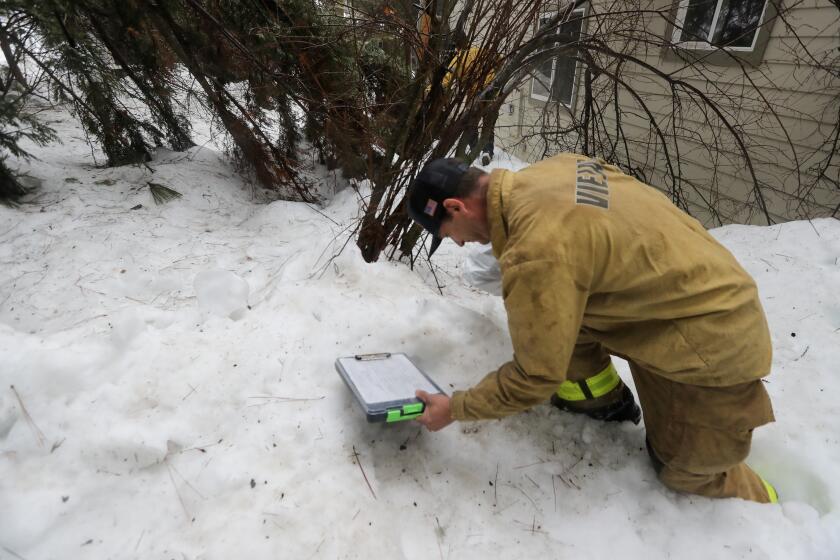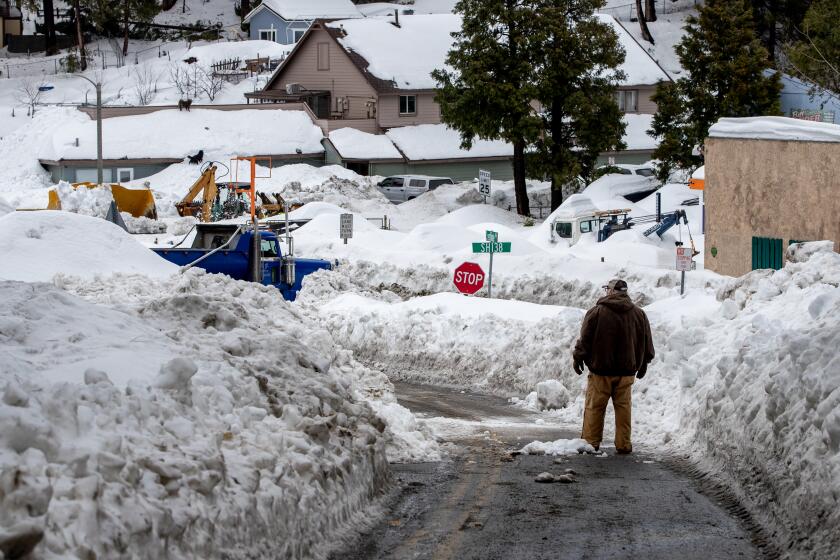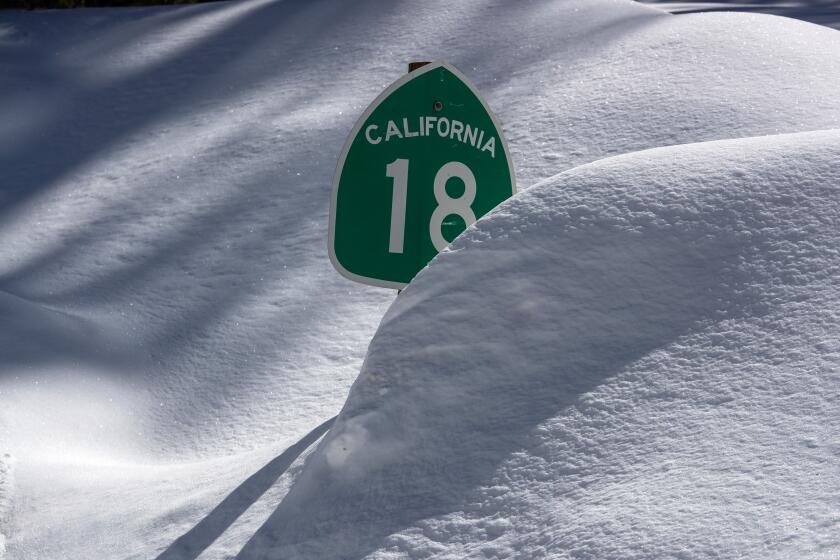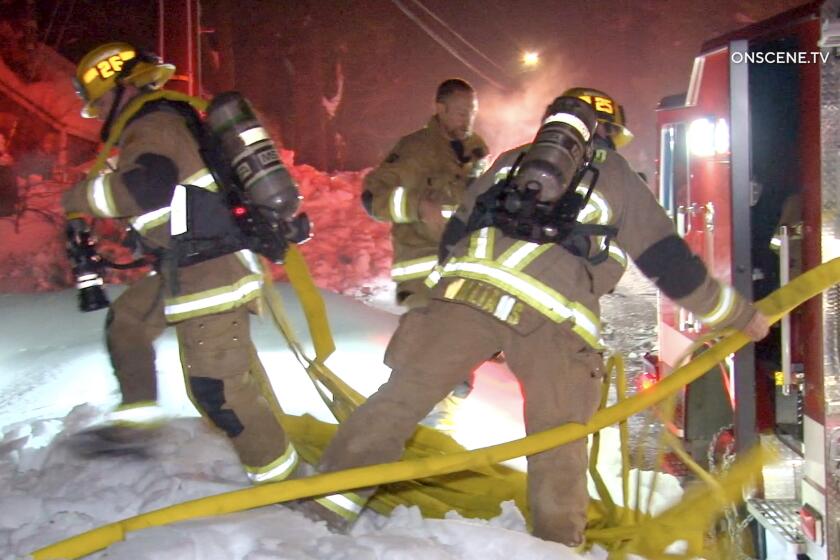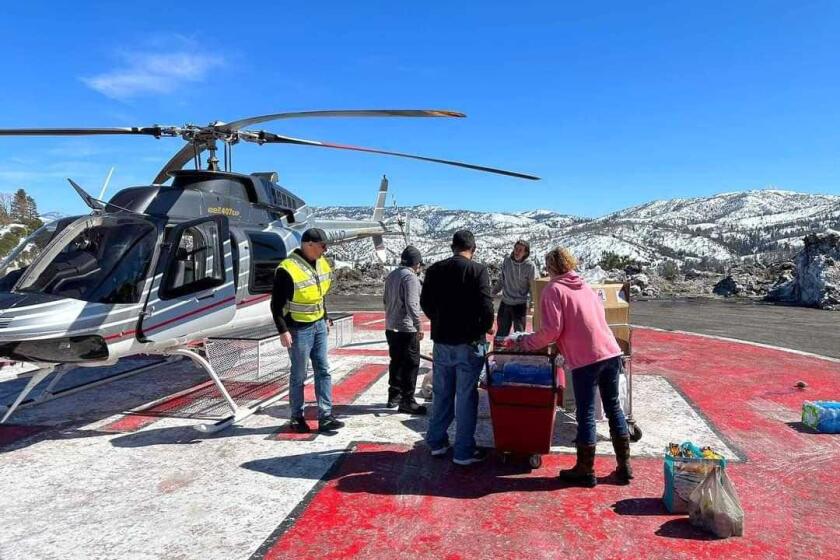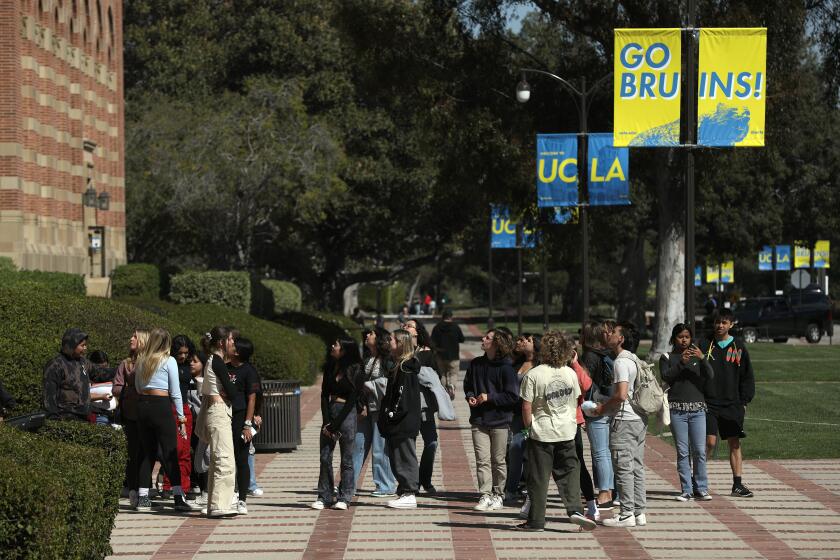‘A shameful situation’: Angry mountain residents trapped by snow ask why help took so long
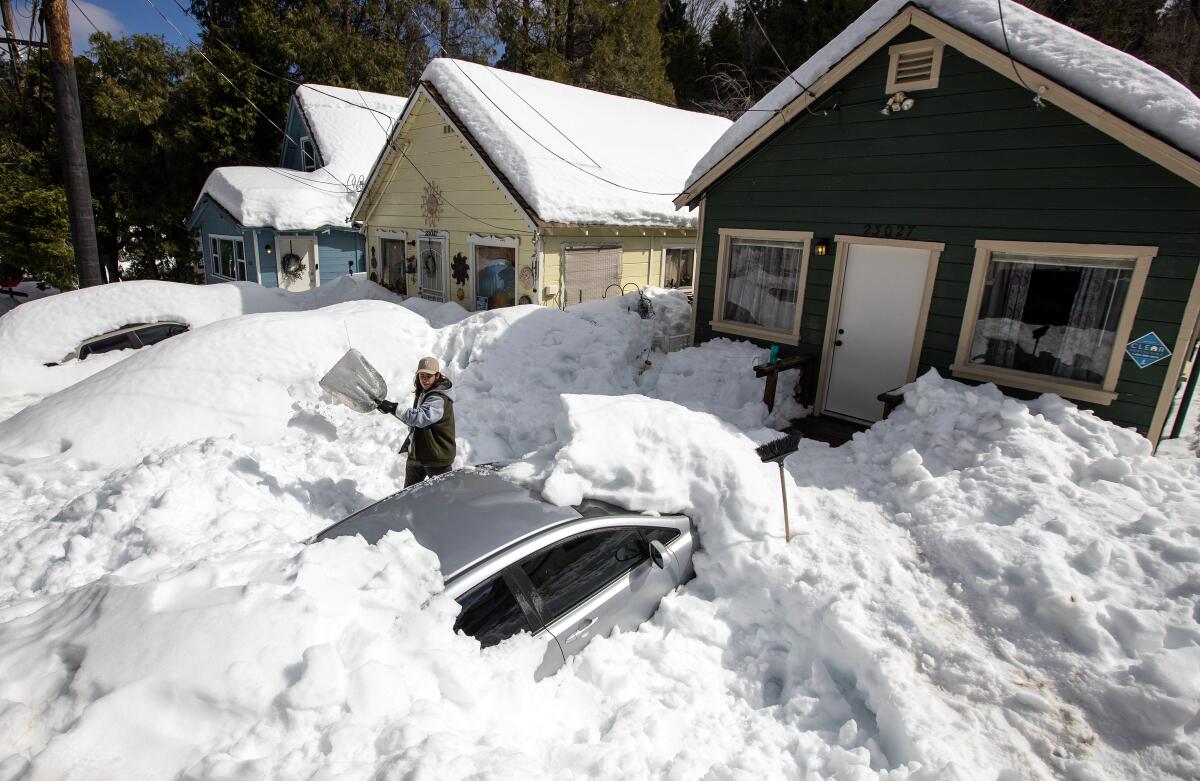
- Share via
Officials knew the San Bernardino County mountains were going to be hit by a bad storm days before an unprecedented blizzard rolled in.
But they found themselves unprepared for the historic amount of snow and the disruptions it would bring. More than 100 inches of snow fell in back-to-back storms over the course of a few days, shutting down most mountain roads and leaving multiple communities stranded, some for nearly two weeks since.
Some of the snowplows local officials had available proved no match for the massive accumulation of snow. And because much of California was also experiencing record-setting wintry weather, supplemental supplies from other counties were unavailable, officials said.
The series of storms and the damage they inflicted on the mountain communities proved to be a harsh lesson for local officials who were tested like never before by the extraordinary challenges.
“The unique and challenging part of this storm was that it hit so many parts of our state simultaneously, so you’re unable to move equipment from other parts of the state that are trying to keep their lifeline roads open,” said Brian Ferguson, a spokesman for the California Governor’s Office of Emergency Services.
California’s deadly storm season continued Friday as the first of two atmospheric river storms descended on the state, prompting evacuation orders.
He called the storms that hit San Bernardino’s highest elevations unprecedented and particularly challenging to respond to.
“It really is a street fight — street by street, neighborhood by neighborhood,” Ferguson said.
It was not until early this week that many roads were finally cleared and residents — some running low on food and medication — could get out. Others still remain stranded and frustrated by the delays in getting their roads cleared.
“It’s a shameful situation because if you watch the local news, you’re gonna see reports saying the county has boots on the ground and that they’re handling everything,” said Megan Vasquez, who lives in Crestline. “My street wasn’t plowed until this morning.”
She and others in surrounding communities question why officials were not better prepared. She said a private resident — not the county — plowed her neighborhood’s street Tuesday morning.
“It definitely felt like we were being forgotten,” said Vasquez, who helped start a food distribution center for her neighborhood after many couldn’t reach the county’s. “It’s been a very disheartening time to see the lack of ... officials actually coming in and trying to do something for this area.”
Some officials have already acknowledged the need to learn from the storm.
“Hindsight is always 2020,” San Bernardino County Chief Executive Leonard Hernandez said during a recent video briefing. “Even though I believe the team did an amazing job of mobilizing before, if the National Weather Service ever issues a blizzard warning again, we will take a different approach immediately.”
Crews struggle to clear roads in the San Bernardino Mountains as frustration grows among stranded residents.
But the storms’ strength was also new for the county: Ahead of the initial system’s arrival, the weather service office in San Diego issued its first-ever blizzard warning for the region.
“We’ve never had one before,” Hernandez said Thursday during a livestream on county Supervisor Dawn Rowe’s Facebook page. “We have a pretty set playbook of the different types of disasters in the county, unfortunately, since we’re so large. We have the wildland fires, we have earthquakes, we have floods, we have acts of terror. Well, now we get to add blizzard into our playbook.”
Snowplows were no match for blizzard conditions, leaving San Bernardino Mountain residents stranded
So much snow fell so quickly it rendered ineffective the front-end plows typically used for routine road maintenance, officials previously said. And there wasn’t enough time to request extra equipment from other jurisdictions, though it probably wouldn’t have been available as Northern California was also contending with heavy snow, they added.
“The warning that we had for the blizzard wasn’t weeks,” San Bernardino County Fire Chief Dan Munsey said during a recent news conference. “We only knew 24 to 36 hours there was a strong potential this was going to occur.”
Many residents in the San Bernardino Mountains are still stranded in their homes after back-to-back storms as emergency responders struggle through the snow.
San Bernardino County “planned days in advance, mobilized our complete workforce, brought in all the contractors that we had available” in anticipation of the wintry weather, Hernandez said. But in terms of snowfall, “it was beyond the worst-case scenario.”
“You have our commitment as an organization that there are a lot of lessons that we’re going to learn from this,” he said.
Adam Roser, a meteorologist at the National Weather Service in the San Diego office, said there was “proper warning” even before a blizzard warning was issued.
Daily weather briefings were sent to different partners, including county emergency management, city emergency managers and fire departments, Roser said. There was also a winter storm warning issued before the blizzard warning had gone out.
In the seven days leading up to March 2, more than 150 inches of snow fell near Running Springs, while areas east of Big Bear Lake got 134 inches and 115 inches fell northeast of Mt. Baldy, according to the National Weather Service’s San Diego office. Lake Arrowhead got about 110 inches and Crestline about 100, while the city of Big Bear Lake saw about 85 inches. Forest Falls and Wrightwood received about 70 and 60 inches, respectively.
The California Department of Transportation began preparing last week by placing de-icing agents on state highways, inspecting snow vehicles and clearing storm drains, according to Caltrans spokesman Eric Dionne.
“With all of that said, as an organization, we will do assessments and see where we could have improved,” he said.
San Bernardino County residents have grown increasingly outraged by the failure of officials to clear snow from roads, which has left them stranded for more than a week
More Caltrans crews were also brought into mountain regions before the storm began, he added.
“We advised the traveling public that travel was highly discouraged, yet many still came up,” Dionne said. “There were a lot of abandoned cars on our infrastructure that really slowed production and snow removal efforts.”
While the state bears responsibility for clearing major highways, other roads are the purview of the county. There are also privately owned roads that residents are typically responsible for clearing themselves.
As of Tuesday, San Bernardino County officials said 91% of county roads have been plowed, though San Bernardino County Fire Battalion Chief Mike McClintock said that includes roads that might still only fit single-lane traffic, and still need to be widened.
That’s not to mention the challenge of where to put plowed snow — which officials said has become an ongoing problem.
“The sheer amount of snow that has dropped in our roadways, where do you put it?” McClintock said. “Everywhere has 10 feet of snow ... there’s not a lot of places to put the snow.”
‘A potentially significant and very likely warm atmospheric river event’ is set to hit California later this week, forecasters say.
Big Bear Lake, the only incorporated city among San Bernardino’s highest peaks, has fared relatively better in the storms’ aftermath, which some officials attributed to two factors: It got less snow than western neighbors such as Crestline and Lake Arrowhead, and it had more resources ready to respond quickly.
“Not to take anything away from our fellow partners and county agencies, but they have a much larger area to accommodate,” said Mayor Randall Putz. “We have that advantage.”
He said the city has full control over its six square miles, which includes budgeting, resources and staffing — whereas harder-hit areas like Lake Arrowhead or Running Springs are all serviced by the county. With its own public works team, contractors, leased equipment and around-the-clock response, Big Bear Lake had more of its roads cleared faster, though it’s still a work in progress, officials said. As of Monday, most were passable, though not to their full width, and many driveways remained blocked by berms.
“This is basically what we think about every winter, it’s not a surprise for us,” said Rick Herrick, a Big Bear Lake council member. “We want to get the roads open, then our visitors can come up, then the businesses will flourish.”
The rare ‘triple dip’ of La Niña was the first time in the 21st century the system appeared three years in a row. Now it could give way to El Niño.
In the meantime, communities up and down California are still reeling from a winter that’s brought not just blanketing snow, but record-shattering rainfall and disastrous flooding.
“What we are seeing here, again, is just another example of the challenges we face as a state due to a changing climate: Weather whiplash of extreme heat followed by torrential rains followed by snow followed by drought,” Ferguson said. “So we continue to evolve as a state to meet this need, but disasters continue to be more frequent and more severe.”
Although progress has been made in recent days, the work is far from over.
Rachelle Angere, of Crestline, spent the last six days without electricity. She and her Jack Russell terrier, Bully, were snowed-in at a friend’s house. They burned lots of paper and wood.
“When we ran out of wood, I was digging in the snow for more wood to burn,” Angere said Tuesday while picking up food at a county-operated food distribution site at the Crestline Library.
Her electricity came back Monday night, and the roads around her neighborhood were cleared in the early morning. But the roads that lead to her home remained blocked, and she blames the county for not acting sooner to clear them.
“If they would have plowed from the beginning, every few hours, it wouldn’t be as dramatic as it is now,” Angere said. “I was on the road and it was just ridiculous.”
She can walk around the main drag in Crestline but is worried that if she leaves to go down the mountain for supplies, she might not be able to return.
“I feel trapped here,” she said as she shouldered a loaf of bread and several boxes of food.
